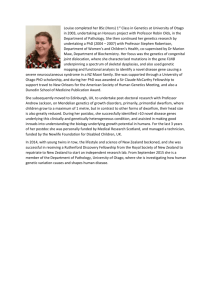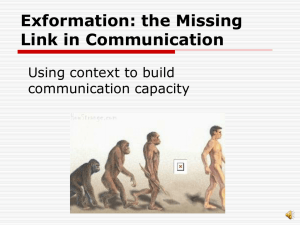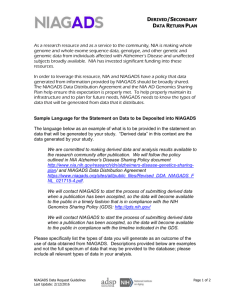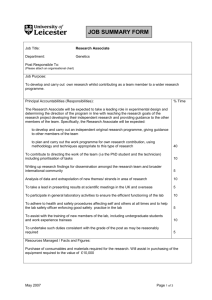NEUROBIOLOGY OF DISEASE: Pathophysiology of
advertisement
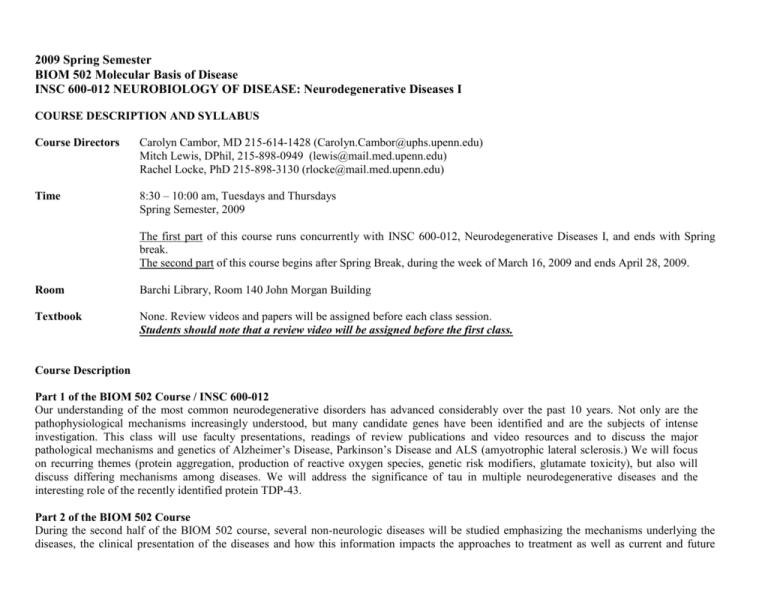
2009 Spring Semester BIOM 502 Molecular Basis of Disease INSC 600-012 NEUROBIOLOGY OF DISEASE: Neurodegenerative Diseases I COURSE DESCRIPTION AND SYLLABUS Course Directors Carolyn Cambor, MD 215-614-1428 (Carolyn.Cambor@uphs.upenn.edu) Mitch Lewis, DPhil, 215-898-0949 (lewis@mail.med.upenn.edu) Rachel Locke, PhD 215-898-3130 (rlocke@mail.med.upenn.edu) Time 8:30 – 10:00 am, Tuesdays and Thursdays Spring Semester, 2009 The first part of this course runs concurrently with INSC 600-012, Neurodegenerative Diseases I, and ends with Spring break. The second part of this course begins after Spring Break, during the week of March 16, 2009 and ends April 28, 2009. Room Barchi Library, Room 140 John Morgan Building Textbook None. Review videos and papers will be assigned before each class session. Students should note that a review video will be assigned before the first class. Course Description Part 1 of the BIOM 502 Course / INSC 600-012 Our understanding of the most common neurodegenerative disorders has advanced considerably over the past 10 years. Not only are the pathophysiological mechanisms increasingly understood, but many candidate genes have been identified and are the subjects of intense investigation. This class will use faculty presentations, readings of review publications and video resources and to discuss the major pathological mechanisms and genetics of Alzheimer’s Disease, Parkinson’s Disease and ALS (amyotrophic lateral sclerosis.) We will focus on recurring themes (protein aggregation, production of reactive oxygen species, genetic risk modifiers, glutamate toxicity), but also will discuss differing mechanisms among diseases. We will address the significance of tau in multiple neurodegenerative diseases and the interesting role of the recently identified protein TDP-43. Part 2 of the BIOM 502 Course During the second half of the BIOM 502 course, several non-neurologic diseases will be studied emphasizing the mechanisms underlying the diseases, the clinical presentation of the diseases and how this information impacts the approaches to treatment as well as current and future research efforts for each disease. This part of the course will study inflammatory and neoplastic diseases of the GI tract (inflammatory bowel disease & colon cancer), diabetes mellitus and chronic myelogenous leukemia. Goals Specific goals will be identified for each session. In general, the goal of all lectures is to give students of the basic sciences a broad understanding of the pathology underlying disease. Faculty The faculty represent a range of departments and expertise in the basic science and clinical aspects of the disorders to be covered. Faculty will lecture and/or participate in the discussion of papers. Class format Typical class format 45-55 min faculty lecture, followed by 30-40 min for student presentation, or discussion of assigned paper or video. Lecturers and course directors will facilitate the discussion. Posted student questions about the assigned review paper or video will be addressed at this time (see “requirements and grading.”) Class format on student presentation days During the last few class sessions prior to spring break, and again at the end of the course, students will present primary research papers to the group (see “requirements and grading”.) Requirements and grading In addition to course attendance, the following are expected of the students: a) Student preparation: These are to be completed BEFORE the class session to which they are related. Students will watch an introductory video, visit a website, and/or read a paper in advance of each class. Please see the syllabus for assignments. The most up to date copy of the syllabus can always be found here: http://www.neurobiologyofdisease.pbwiki.com. ai) Submission of discussion questions: students must submit, via the wiki site (part 1 of the course) or blackboard (part 2 of the course), 2 questions about the materials studied as “student preparation.” Questions must be posted at least 2 hours in advance of the class session. These questions will form the basis for the in-class discussions which will follow each lecture. Each student may “pass” twice. aii) Blogging: For part 1 of the course, students will write a short (~500 words) blog about the material they have read or viewed in preparation for the session. Access to the blog is though our wiki at http://www.neurobiologyofdisease.pbwiki.com. Login with your email address; you then will receive an email to which you need to respond to create a password before logging in. Further blogging instructions are on the wiki. c) Consistent participation in the discussions that follow each lecture: Level of questions is not as important as active participation. d) Quality of presentation: each student will make one ~20 minute presentation during each half of the course. Papers will be assigned at last 1 week in advance and students will work in pairs or groups to prepare and present their paper(s). Each presentation is expected to address: background, description of materials and methods used, results, conclusions, questions the study answered and those it left unanswered, critique and/or questions for discussion, possible future directions. Students are to present in a professional manner. If possible, the presentation/presenters should address the questions submitted to the wiki by other students in the course. Otherwise student questions may be addressed during the discussion. 2009 BIOM 502 / INSC 600-012 – Part 1 Week # 1 Tuesday Lecturer Thursday Lecturer Jan 15 Clinical presentation of AD; diagnostic criteria; AD biomarkers: biochemical and imaging Steven Arnold, MD Student preparation: Choose one: a) Video - overview of AD: http://www.med.upenn.edu/neurobiologyofdisease/NBDoverview07/NB Doverview07.html b) NIA website – read 5 pages: http://www.nia.nih.gov/Alzheimers/AlzheimersInformation/GeneralInfo/ http://www.nia.nih.gov/Alzheimers/AlzheimersInformation/Causes/ http://www.nia.nih.gov/Alzheimers/AlzheimersInformation/Symptoms/ http://www.nia.nih.gov/Alzheimers/AlzheimersInformation/Diagnosis/ http://www.nia.nih.gov/Alzheimers/AlzheimersInformation/Treatment/ Blog topic: what you found most interesting or surprising or, alternatively, what you found most confusing or challenging to understand and why. 2 Jan 20 AD Genetics Student preparation: Look at this helpful diagram: Jerry Schellenb erg, PhD Jan 22 Protein misfolding as a common mechanism among many neurodegenerative disorders; Overview of clinical trials in AD (inclu. which pathophysiological mechanisms were targeted) http://www.cmaj.ca/cgi/content-nw/full/178/5/548/F113 Then -- Read these (some info will be redundant): http://www.nia.nih.gov/Alzheimers/Publications/geneticsfs.htm http://www.klinikundforschung.de/sup/heft3/broeck.htm http://www.ncbi.nlm.nih.gov/bookshelf/br.fcgi?book=gene&part=alzheim er OR Read this paper “Genetics of Alzheimer’s Disease: A Centennial Review” listed on the wiki as ertekin-taner2007NeurolClin_ADgenetics-review.pdf Blog topic: Option 1: Comment on / hypothesize about how you imagine that genetics plays a role in the AD cases that are not due to single gene mutations. Option 2: Describe what you found most interesting or surprising or, alternatively, what you found most confusing or challenging to understand and why. Student preparation: a) Review basics of folding - try Wikipedia: http://en.wikipedia.org/wiki/Protein_folding b) Then do one of the following. You should probably check out each thing quickly and then do one more thoroughly. Listen to this lecture (1st ~ half is a bit of review): http://www.iac-usnc.org/ndw2004/selkoe/selkoe.html OR Explore this symposium: http://www.nature.com/horizon/proteinfolding/index. html OR Read one of these papers: winklhofer2008EMBO_protein_misfolding_NDD.pdf soto2003NRN_proteinMisfolding_in_ND.pdf (older but good on basics) Blog topic: Choose 1 1- How do misfolded proteins cause neurodegeneration? 2- Are aggregates of misfolded proteins a cause or a consequence of neurodegeneration; are they an epiphenomenon or are they protective? 3- Describe what you found most interesting or surprising or, alternatively, what you found most confusing or challenging to understand and why. Virginia M.Y. Lee, PhD 3 Jan 27 Mechanisms of AD pathogenesis and pathophysiology, e.g. amyloid cascade hypothesis, tau, and the therapeutic approaches they suggest. Review of recently completed clinical trials and of the NSAID (non-steroidal anti-inflammatory) trial. Read/review/skim this to be familiar with terminology about clinical trials: http://www.nia.nih.gov/Alzheimers/ResearchInformation/ ClinicalTrials/trialsQandA.htm (clinical trials terminology) Read this: selkoe2008HandbookClinNeurol_Abeta_AD.pdf Check out this nice summary: http://www.alzforum.org/res/adh/cur/knowntheamyloidcas cade.asp (a good summary of the amyloid cascade hypothesis and evidence in support of) Blog topic: Given what you now know and have read for today, comment on and/or expand upon a blog written by someone else (from Jan 15, 20 or 22). SEE WIKI FOR FURTHER INSTRUCTIONS. YOU WILL NOT BE EDITING THEIR ORIGINAL BLOG IN ANY WAY. Virginia M.Y. Lee, PhD Jan 29 Tau: involvement in AD and FTD (fronto-temporal dementia). Potential tau and tau-related (e.g. MT stabilizing, kinase inhibiting) therapeutics. Student preparation: Read: 1) ballatore2007NatRevNeuro_Tau_AD_NDdisease.pdf AND 2) trojanowski2008AlzDementia_FTDdrugDiscovery.pdf You might want to look at a lecture that Virginia Lee gave about tau in 2004: http://www.iac-usnc.org/ndw2004/lee/lee.html (If you’re interested in genetics, this might be good supplemental material: dermaut2005TIG_tau_AD_FTD.pdf) FTD overviews: http://www.caregiver.org/caregiver/jsp/content_node.jsp? nodeid=573 http://en.wikipedia.org/wiki/Frontotemporal_dementia http://www.nia.nih.gov/NR/rdonlyres/73382FBD-A1074E15-9701-85D64854B4ED/2455/conv09n4.pdf Blog topic:Choose 1: 1 – Discuss one of the therapeutic strategies targeting tau that are presented in Ballatore et. al. Table 2. 2- Give your perspective on this quote from Ballatore et al p 670: “It should be noted, however, that the onset and progression of the disease may not necessarily be best represented by an unequivocal linear sequence of causes and effects, where one single ‘root’ cause is responsible for the entire cascade of events. With the recognition that amplification mechanisms exist that could effectively short‑circuit cause and effect and thereby exacerbate each‑others’ detrimental effects, it is plausible that disease progression may lie in the ability to set in motions such self‑sustaining cycles.” John Trojanowski MD, PhD 4 Feb 3 Glutamate toxicity and the role of glutamate transporters. Examples of glutamate modulators as therapeutic agents. Student preparation: Choose 1 http://www.med.upenn.edu/neurobiologyofdisease/ MechInjuryProtect/MechInjuryProtect.html (click on talk by Robinson – you’ll need RealPlayer) Or here are a couple of papers Mike recommended. You might want to skim the longer of the two: rothstein2005Nature_lactams_NP_glu_transporter. pdf sheldon2007NeurochemInt_glu_transporters_NDdis ease.pdf Blog topic: Integrate the information about glutamate toxicity into what you already know about AD. Mike Robinson, PhD Feb 5 Parkinson’s Disease: Clinical overview and review of clinical trials Student preparation: Choose 1 Read: http://www.ninds.nih.gov/disorders/parkinsons_dise ase/detail_parkinsons_disease.htm OR: View Video – PD lecture by David Lynch http://www.med.upenn.edu/neurobiologyofdisease/ NBDoverview07/NBDoverview07.html Blog topic: Your choice: 1- What you found most interesting or surprising or, alternatively, what you found most confusing or challenging to understand and why. 2- Compare and contrast PD with AD – your choice of what to compare/contrast. Nabila Dahodwala, MD 5 Feb 10 Parkinson’s Disease: genetics – alpha synuclein, parkin, DJ1, PINK1, and LRRK2. Gauchier’s mutations … Gene therapy for PD. Student preparation: Choose 1 (or skim all) lee2008BrainResRev_PD_genetics.pdf biskup2008JNeurol_PD_genetics.pdf devine2008FEBS_PD_genetics.pdf pankratz2009HumanGenetics_PD_GWAS.pdf klein2007Neurology_PD_genetics.pdf thomas2007HumMoledGenetics_PD.pdf GeneTests website (GeneReviews) PD general http://www.ncbi.nlm.nih.gov/bookshelf/br.fcgi?book= gene&part=parkinson-overview LRRK2-associated PD http://www.ncbi.nlm.nih.gov/bookshelf/br.fcgi?book= gene&part=lrrk2 Juvenile PD http://www.ncbi.nlm.nih.gov/bookshelf/br.fcgi?book= gene&part=jpd Blog topic: None. Add to chart comparing PD to AD. Make one ppt slide illustrating a key concept that we have covered in the class so far. List of key concepts is on the wiki. Please put your name next to the one you want to do. Vivianna Van Deerlin, MD, PhD Feb 12 Parkinson’s Disease: pathological mechanisms; review of mechanisms upon which clinical trials / medications have been based: e.g. antioxidants (monoamine oxidase B inhibitor, Co Q10 etc); dopamine agonists, Catechol-O-methyl transferase (COMT) inhibitors, NMDA receptor antagonists… Student preparation: henchcliffe2008NatureClinPract_PD_oxidStress.pdf moore2005AnnRevNeurol_PD_molecPath.pdf Blog topic: The different disease pathways active in PD (mitochondria, oxidative stress, UPS...), focusing on whether they are independent or connected with each other, and how this relates to treatment of the disease (ie can we treat one or do we need to treat all three pathways?). Benoit Giasson, PhD Feb 17 Oxidative stress: Role across various neurodegenerative disorders and role as potential therapeutic agents. 6 Harry Ischiropol ous, PhD Feb 19 Clinical overview of FTD and ALS Student preparation: grossman2004Neurocase_aphasia.pdf miller2007HumanFrontalLobes_FTD.pdf Student preparation: henchcliffe2008NatureClinPract_PD_oxidStress.pdf You also may look at Harry’s previous lectures, if you like: http://www.med.upenn.edu/neurobiologyofdisease/ MechInjuryProtect/MechInjuryProtect.html No blog (discussion questions only)– prepare for student presentations Blog topic: Is oxidative stress a unifying mechanism for neurodegenration ? If yes how and why have antioxidant failed? Feb 24 TPD43: a newly identified pathological protein in sporadic ALS. Pathology, pathological mechanisms, genetics; imagining a “bench to bedside” story… 7 Virginia M.Y. Lee, PhD Feb 26 Student Presentations Student preparation: No blog (discussion questions only)– prepare for student presentations March 3 Student Presentations 8 March 5 Student presentations 2009 BIOM 502 – Part 2 Week # Date Topic Presenter Murray Grossman, MD Inflammatory & Neoplastic Diseases of the Colon 1 Tuesday, March 17 Inflammatory Bowel Disease Thursday, March 19 2 Tuesday, March 24 Emma E. Furth, MD Emma E. Furth, MD Cancers of the GI tract Thursday, March 26 Emma E. Furth, MD Emma E. Furth, MD Diabetes Mellitus 3 4 Tuesday, March 31 Thursday, April 2 Glucose metabolism; normal pancreas anatomy & Mitch Lewis, DPhil & Carolyn Cambor, MD histology Pathophysiology & clinical presentation of diabetes Serena Cardillo, MD Tuesday, April 7 Research articles TBA Mike Rickels, MD Thursday, April 9 Research articles TBA Mike Rickels, MD Chronic Myelogenous Leukemia 5 Tuesday, April 14 Background & mechanisms Martin Carroll, MD, PhD Thursday, April 16 Approach to treatment & research Martin Carroll, MD, PhD Student presentations 6 7 Tuesday, April 21 TBA Thursday, April 23 TBA Tuesday, April 28 TBA



